Google FB503 Smart Watch User Manual Product Manual Draft 05012017
Fitbit, Inc. Smart Watch Product Manual Draft 05012017
Google >
USERS MANUAL FB503__05032017
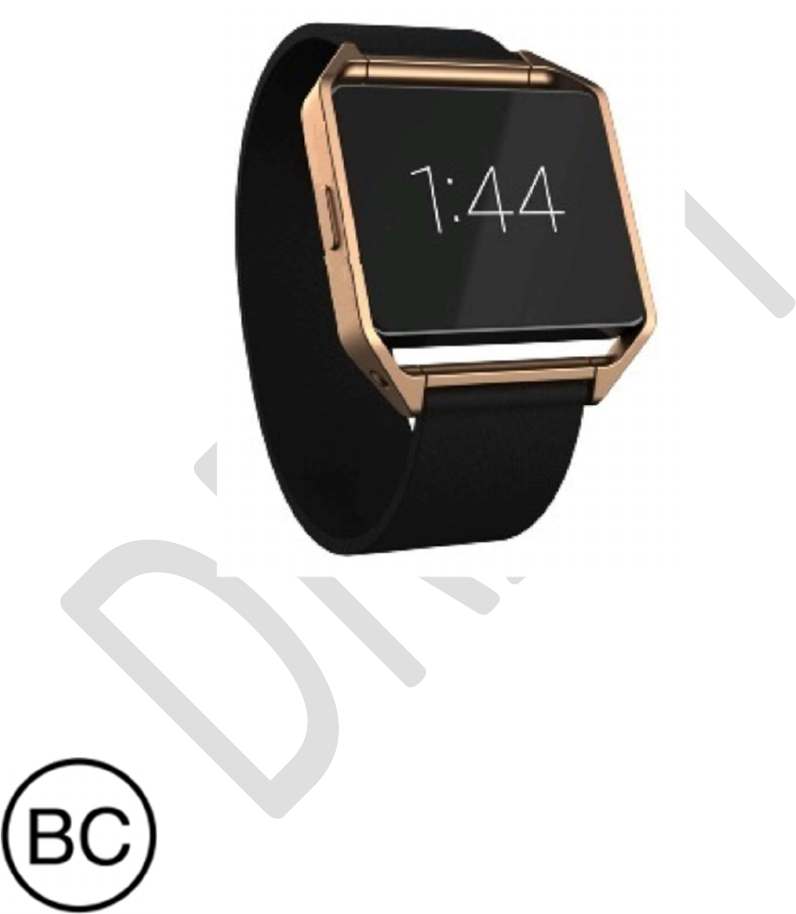
Fitbit IONIC
Product Manual
Version 1.0

Table of Contents
Getting Started ............................................................................................................................................ 1
What you’ll find in the box ....................................................................................................................... 1
What you’ll find in this document ............................................................................................................ 1
Setting up your Fitbit Ionic ........................................................................................................................ 2
Setting up your tracker using a Fitbit app ................................................................................................. 2
Setting up your tracker using Fitbit Connect ............................................................................................ 2
Downloading Fitbit Connect ................................................................................................................. 2
Installing Fitbit Connect and pairing your tracker ................................................................................ 2
Syncing your data ................................................................................................................................. 3
Getting to know your Fitbit Ionic .............................................................................................................. 4
Wearing your Fitbit Ionic .......................................................................................................................... 4
Specifying dominant or non-dominant wrist......................................................................................... 4
Using your Fitbit Ionic in wet conditions ............................................................................................. 4
Changing the band ................................................................................................................................ 5
Getting around your Fitbit Ionic ............................................................................................................... 5
Changing the clock face ............................................................................................................................ 5
Measuring heart rate ................................................................................................................................. 5
Default heart rate zones......................................................................................................................... 5
Custom heart rate zones ........................................................................................................................ 6
Missing signal ....................................................................................................................................... 6
Battery life and charging ........................................................................................................................... 7
Caring for your Fitbit Ionic ....................................................................................................................... 7
Automatic Tracking with Fitbit Ionic ....................................................................................................... 8

Tracking all-day stats ................................................................................................................................ 8
Tracking sleep ........................................................................................................................................... 8
Tracking a daily activity goal.................................................................................................................... 8
Choosing a goal to celebrate ................................................................................................................. 9
Tracking Exercise with Fitbit Ionic ......................................................................................................... 10
Tracking a run ......................................................................................................................................... 10
Tracking other exercise ........................................................................................................................... 11
Using other functions during exercise .................................................................................................... 12
Choosing exercises to track .................................................................................................................... 12
Using Silent Alarms .................................................................................................................................. 13
Setting silent alarms ................................................................................................................................ 13
Dismissing or snoozing silent alarms...................................................................................................... 13
Enabling or disabling silent alarms ......................................................................................................... 13
Receiving Call, Text, & Calendar Notifications ..................................................................................... 14
Enabling notifications ............................................................................................................................. 14
Viewing notifications .............................................................................................................................. 14
Disabling notifications ............................................................................................................................ 15
Controlling Music ..................................................................................................................................... 16
Enabling music control with the Fitbit app for iOS ................................................................................ 16
Enabling music control with the Fitbit app for Android ......................................................................... 16
Enabling music control with the Fitbit app for Windows 10 .................................................................. 16
Controlling music with your Fitbit Ionic ................................................................................................ 16
Managing Settings on your Fitbit Ionic .................................................................................................. 18
Quick View ............................................................................................................................................. 18
Brightness ............................................................................................................................................... 18

Heart Rate Tracking ................................................................................................................................ 19
Regulatory Info ....................................................................................................................................... 19
Version Number ...................................................................................................................................... 19
Shutdown ................................................................................................................................................ 19
Regulatory Info ....................................................................................................................................... 19
Updating your Fitbit Ionic ....................................................................................................................... 20
Restarting your Fitbit Ionic ..................................................................................................................... 21
Fitbit Ionic General Info & Specifications .............................................................................................. 22
Sensors and motors ................................................................................................................................. 22
Battery ..................................................................................................................................................... 22
Memory ................................................................................................................................................... 22
Display .................................................................................................................................................... 22
Environmental conditions ....................................................................................................................... 22
Help ......................................................................................................................................................... 23
Return policy and warranty ..................................................................................................................... 23
Regulatory & Safety Notices .................................................................................................................... 24
USA: Federal Communications Commission (FCC) statement ............................................................ 25
Canada: Industry Canada (IC) statement .............................................................................................. 26
Safety statement ........................................................................................................................................ 27
European Union (EU) ................................................................................................................................. 1
Australia and New Zealand ........................................................................................................................ 2
Japan ............................................................................................................................................................ 3
South Korea ................................................................................................................................................. 4
Taiwan .......................................................................................................................................................... 5
United Arab Emirates ................................................................................................................................. 6

Mexico .......................................................................................................................................................... 7
Safety statement .......................................................................................................................................... 8
Important safety and product information ................................................................................................ 8
Disposal and recycling information .......................................................................................................... 9
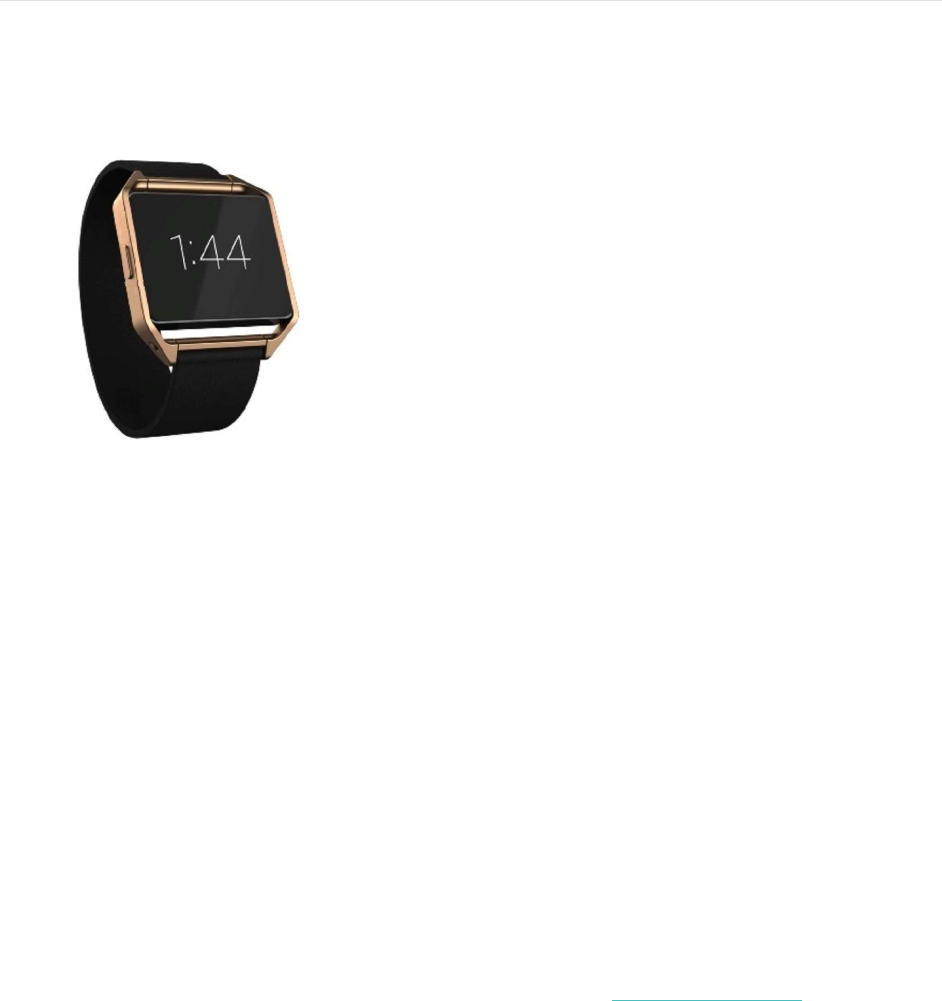
1
Getting Started
What you’ll find in the box
Your Fitbit Ionic box includes:
Fitbit Ionic
Charger
What you’ll find in this document
This manual gets you started quickly setting up your tracker. Setup ensures that your tracker can
synchronize its data with the Fitbit app or your fitbit.com dashboard, where you can get detailed
information on your stats, view historical trends, log food, and more. As soon as setup is complete you’re
ready to start moving.
Next the manual introduces you to your Fitbit Ionic, specifically how to use the buttons and touchscreen
to find your stats and track a run or other exercise.
The remainder of the manual walks you through every function on your Fitbit Ionic and also explains how
to update your tracker when free firmware updates are available. Throughout the manual you’ll notice that
for tasks that can be done in the Fitbit app or fitbit.com dashboard, general Fitbit app instructions will
appear. Most of the tasks can also be done on your fitbit.com dashboard.
The manual concludes by explaining how to restart your Fitbit Ionic in the event you encounter difficulty
with your tracker. All other troubleshooting suggestions, as well as detailed information about how Fitbit
trackers and tasks work, can be found in the articles on our help site, https://help.fitbit.com. Just select
Ionic and then pick from a category to browse, or enter a search term to find something specific. Do us a
favor and rate the articles you read—it’s how we know we’re getting you the right information at the right
time!

2
Setting up your Fitbit Ionic
Your Fitbit Ionic works best with a mobile device, but if you don’t have one we make it possible to set up
and sync your tracker using a Bluetooth-enabled computer instead. We recommend:
Using the Fitbit app for iOS if you have an Apple iOS device, such as an iPhone
Using the Fitbit app for Android if you have a Google Android device, such as a Samsung
Galaxy
Using the Fitbit app for Windows 10 if you have a Windows Phone or any tablet or computer
running Windows 10
Using Fitbit Connect on your Bluetooth-enabled computer if you have a Mac or if you have a PC
that isn’t running Windows 10
Setting up your tracker using a Fitbit app
Over 120 mobile devices that support Bluetooth 4.0 technology allow you to set up and wirelessly sync
your Fitbit Ionic. To see if your iOS, Android, or Windows 10 mobile device is compatible with your
Fitbit Ionic, visit www.fitbit.com/devices. If your device is listed, you can then download our free mobile
app and follow the setup process in the app. If your device is not listed, check back frequently because
we’re continually adding new devices.
Setting up your tracker using Fitbit Connect
Fitbit Connect is a software application that connects (“pairs”) your Ionic to your fitbit.com dashboard,
where you can view your data, log food, and more. Your tracker data synchronizes with your dashboard
using Bluetooth. If your computer is not Bluetooth enabled, you’ll need to purchase a wireless sync
dongle from Fitbit to synchronize your data with your computer.
Downloading Fitbit Connect
1. Go to http://www.fitbit.com/setup.
2. Scroll down and click the option to download. If the button does not correctly show your type of
computer (for example, if it says “Download for Mac” when you’re on a PC), choose the correct
type before clicking the button.
3. When prompted, save the file.
Installing Fitbit Connect and pairing your tracker
1. Make sure your tracker is nearby.
2. Go to the folder containing the file you just downloaded and look for the installation program:
3
- For Mac: Install Fitbit Connect.pkg
- For Windows: FitbitConnect_Win.exe
3. Double-click the file name to start the installation process.
4. Follow the brief onscreen instructions to finish setting up. You’re ready to get moving.
Syncing your data
Now that Fitbit Connect is installed, your Ionic will automatically and wirelessly synchronize its data to
your dashboard every 15-20 minutes under these conditions:
Your Ionic is within 15-20 feet of your computer and has new data to upload (meaning if you
haven’t moved, an automatic sync won’t occur).
Your computer is powered on, awake, and connected to the Internet.
Bluetooth is enabled.
To manually synchronize your Ionic with your dashboard, click the Fitbit Connect icon on your computer
(located near the date and time) and click Sync Now.

4
Getting to know your Fitbit Ionic
Wearing your Fitbit Ionic
Your Fitbit Ionic should be worn on your wrist. While it may track stats such as steps and floors when
placed in a pocket or backpack, it is most reliable on the wrist. For all-day wear, your Fitbit Ionic should
usually rest a finger’s width below your wrist bone and lay flat (as you would normally wear a watch).
FPO (image of Ionic on wrist)
As with all heart-rate monitoring technology, whether a chest strap or a wrist-based sensor, accuracy is
affected by personal physiology, location of wear, and type of movement. For improved heart rate
accuracy keep these tips in mind:
1. Experiment with wearing the tracker higher on your wrist during exercise. Because blood flow in
your arm increases the farther up you go, moving the tracker up a couple inches can improve the
heart rate signal. Also, many exercises such as spinning cause you to bend your wrist frequently,
which is more likely to interfere with the heart rate signal if the tracker is lower on your wrist.
FPO (image of Ionic & 3 fingers)
2. Do not wear your tracker too tight; a tight band restricts blood flow, potentially affecting the heart
rate signal. That being said, the tracker should also be slightly tighter (snug but not constricting)
during exercise than during all-day wear.
3. With high-intensity interval training or other activities where your wrist is moving vigorously and
non-rhythmically, the movement may prevent the sensor from finding an accurate heart rate.
Similarly, with exercises such as weight lifting or rowing, your wrist muscles may flex in such a
way that the band tightens and loosens during exercise. Try relaxing your wrist and staying still
briefly (about 10 seconds), after which you should see an accurate heart rate reading.
Specifying dominant or non-dominant wrist
By default Fitbit assumes you wear your tracker on your non-dominant wrist. If you wear your tracker on
your dominant wrist instead (meaning, the hand you write with), change this setting. You can find the
Wrist setting in the Fitbit app or in your device settings on fitbit.com.
Using your Fitbit Ionic in wet conditions
Your Fitbit Ionic is splash-proof, rain-proof, and can withstand even the sweatiest workout. It is not
designed to be worn swimming. We also recommend removing your tracker before showering. After
getting your tracker wet, dry it thoroughly before putting it back on. For more details, see
https://www.fitbit.com/productcare.
5
Changing the band
Getting around your Fitbit Ionic
The Fitbit Ionic has a touch screen with a colored LCD and three buttons: Action, Select, and Back. Take
a moment to memorize these button names and their location or refer back to this image when reading the
tasks in this manual:
Your Fitbit Ionic has a clock, where you can see your all-day stats at a glance, and specialized menus for
tracking exercise, setting alarms, and other tasks. At any time you can press the Back button to return to
the clock.
When viewing the clock, tap on the screen to quickly see all-day stats and the date [true for all clocks?].
Swipe upwards to see any notifications or music.
Also from the clock, swipe right to see today’s stats and several menus:
o Today—Tap to see your steps taken, heart rate, distance covered, calories burned, and
floors climbed
o Exercise—Tap to open and swipe right to see your options.
o Time—Tap to open and swipe right to choose a stopwatch or countdown.
o Alarms—Tap to open and disable or enable any alarms you’ve set.
o Settings—Tap to open and and scroll up to see your options.
FPO (images of each menu screen)
The functions of the Select and Action buttons vary depending on what you’re doing. Generally, to
initiate an action you can tap the screen or press the closest button.
Changing the clock face
Your Ionic has several clock faces to choose from. Each face changes the appearance of the all-day stats
to resemble the clock style, so try them all and pick the one you like best. You can find the Clock Display
setting in the Fitbit app or in your device settings on fitbit.com.
Measuring heart rate
When your heart beats, your capillaries expand and contract based on blood volume changes. PurePulse™
LED lights on the back of your Fitbit Ionic reflect onto the skin to detect blood volume changes, and
finely tuned algorithms are applied to measure heart rate automatically and continuously.
When viewing the clock, tap the screen until the heart icon and number appear [accurate for all clock
faces?]. This is your current heart rate.
Default heart rate zones
Heart rate zones let you target different training intensities to help you optimize your workout. Your
zones are calculated based on your estimated maximum heart rate, which is 220 minus your age.

6
To quickly determine what zone you’re in, tap the clock screen until a heart icon appears. Depending on
your current zone, different versions of a heart will be shown.
Out of zone Fat burn Cardio Peak
When you’re out of zone, which means you’re below 50% of your maximum heart rate, your
heart rate may be elevated but not enough to be considered exercise.
Fat Burn zone, which means your heart rate is between 50% and 69% of your maximum, is the
low-to-medium intensity exercise zone and may be a good place to start for those new to exercise.
It’s called the Fat Burn zone because a higher percentage of calories are burned from fat, but the
total calorie burn rate is lower.
Cardio zone, which means your heart rate is between 70% and 84% of your maximum, is the
medium-to-high intensity exercise zone. In this zone you’re pushing yourself but not straining.
For most people this is the exercise zone to target.
Peak zone, which means your heart rate is 85% of your maximum or higher, is the high-intensity
exercise zone. Peak zone is for short intense sessions that improve performance and speed.
At any time you can check your Fitbit app or fitbit.com dashboard to see the amount of time you’ve
spent in each zone.
Custom heart rate zones
Instead of using the default heart rate zones, you can configure a custom zone. When your heart rate is
above or below your custom zone you’ll see an outline of a heart, and when your heart rate is in your
custom zone you’ll see a solid heart.
At any time you can check your Fitbit app or fitbit.com dashboard to see the amount of time you’ve spent
in your custom zone.
For more details about heart rate monitoring, including links to relevant American Heart Association
information, see our “Heart rate FAQs” article on https://help.fitbit.com.
Missing signal
The Fitbit Ionic continuously monitors your heart rate while you’re exercising and throughout the day.
However, occasionally the heart rate monitor may have difficulty finding a good enough signal to show a
hear rate. In those cases, you’ll see this screen:
FPO (HR screen with missing HR)
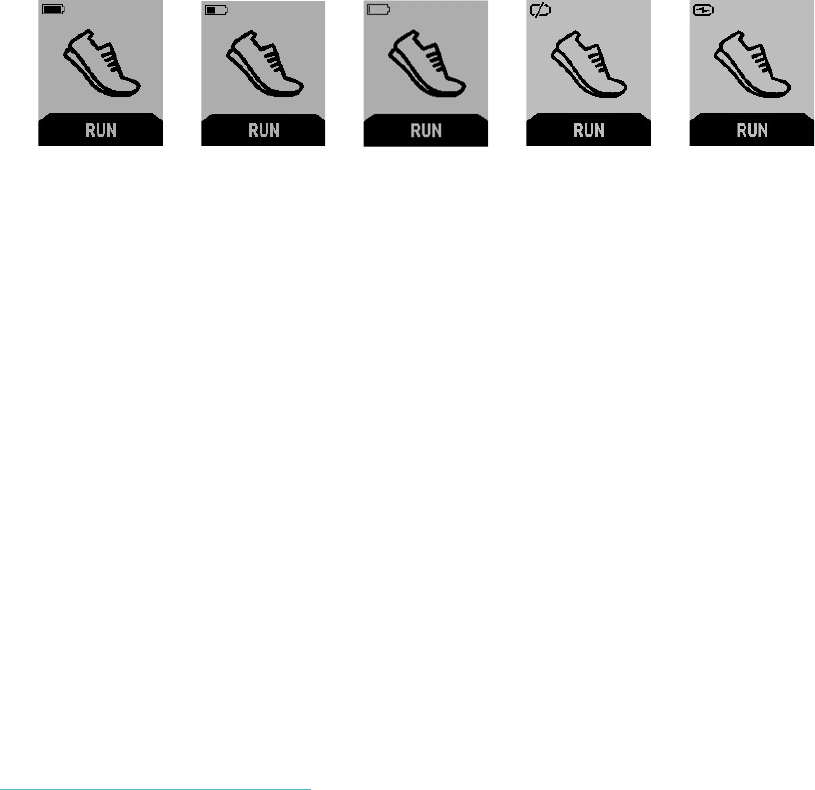
7
If you’re not getting a heart rate signal, first make sure you’re wearing your Fitbit Ionic correctly, either
moving it higher or lower on your wrist or tightening or loosening the band. After a short wait, you
should see your heart rate again. If a heart rate signal is still not found, check your Heart Rate setting.
Battery life and charging
Your fully charged Fitbit Ionic should last 5 days or more as a fitness watch with continuous heart rate
monitoring and activity tracking. GPS your battery life will be different?]
To charge your Fitbit Ionic, [instructions from Daniel]. Charging completely takes 1 to 2 hours.
FPO (image showing how to charge)
When looking at the menu, your tracker’s battery level appears in the top left.
Full Partially Full Very Low Critically Low Charging
If your battery is critically low, charge your Fitbit Ionic as soon as possible.
You can also check your battery level in the Fitbit app or on the fitbit.com dashboard. In these cases, the
battery level shown reflects the last time you synced your Fitbit Ionic so make sure it has synced recently.
If you want to receive a mobile notification or email when your battery is low Log in to your fitbit.com
dashboard.
1. Click the gear icon in the top-right corner of the page and select Settings.
2. Using the navigation tabs on the left, find Notifications and choose which ones you would like to
receive.
3. Click Save.
If you won’t be using your Fitbit Ionic for a while, you can conserve battery life by shutting it down. To
shut down, go into your Settings menu.
Caring for your Fitbit Ionic
Clean and dry your Fitbit Ionic regularly, particularly under the band. Use skin care products sparingly on
the areas of the skin covered by your Fitbit product. For more information, see
https://www.fitbit.com/productcare.

8
Automatic Tracking with Fitbit Ionic
Your Fitbit Ionic tracks a variety of stats automatically whenever you’re wearing it. When you sync your
Ionic, this data is uploaded to your Fitbit app and fibit.com dashboard.
Tracking all-day stats
Your Fitbit Ionic automatically tracks and displays the following all-day stats:
Steps taken
Current heart rate
Distance covered
Calories burned
Floors climbed
To view these stats, display the clock and swipe left to the Today screen. Tap on the Today menu item.
In addition to the stats displayed on your Fitbit Ionic, the following all-day stats are also tracked but
shown only in the Fitbit app or on your fitbit.com dashboard:
Detailed heart rate history, including time spent in heart rate zones
Active minutes
Hours slept and quality of sleep
Your Fitbit Ionic starts tracking your stats for the next day at midnight based on your time zone. Though
your stats reset to zero at midnight, this does not delete the previous day’s data; that data will be uploaded
to fitbit.com the next time you sync your Fitbit Ionic.
You can adjust your time zone through the Fitbit app under Account, or at
www.fitbit.com/user/profile/edit to detect your time zone automatically.
Tracking sleep
Your Fitbit Ionic automatically tracks the hours you sleep and your movement during the night to help
you understand your sleep quality. You don’t need to press any buttons or otherwise enter a “sleep mode”
to begin tracking sleep. Simply wear your Fitbit Ionic to bed. Wearing your Fitbit Ionic while you sleep
has the added benefit of making the Resting Heart Rate measurements on your dashboard more accurate.
If you choose, you can also set a goal for number of hours slept.
To see your sleep data, sync your tracker and then view your results through the Fitbit app or fitbit.com
dashboard.
Tracking a daily activity goal
Your Fitbit Ionic is designed to track your progress towards a goal that you define in your Fitbit app or
fitbit.com dashboard. By default, your daily goal is set to 10,000 steps per day.
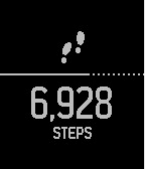
9
A progress ring or bar keeps you motivated. For example, the solid portion of the line below shows that
you’re more than halfway to a goal of 10,000 steps
When you reach your goal your Ionic will vibrate and flash to celebrate.
Choosing a goal to celebrate
Using the Fitbit app or fitbit.com dashboard you can set your Fitbit Ionic to celebrate a daily goal for
steps taken (the default), distance traveled, calories burned, active minutes, or floors climbed. You can
also change the default value. For example, instead of the default daily goal value of 10,000 steps per day,
you may want your Fitbit Ionic to vibrate and flash when you reach 15,000 steps per day.
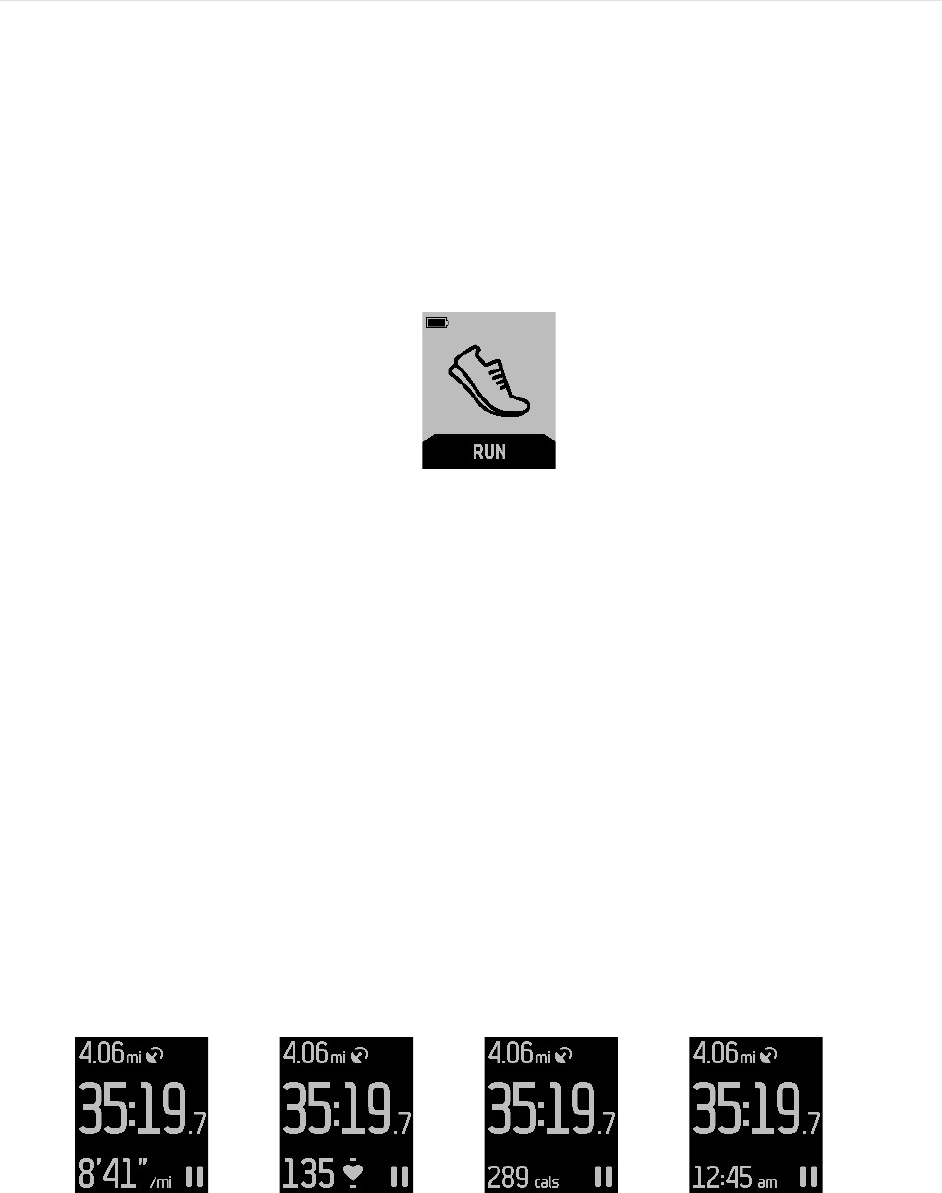
10
Tracking Exercise with Fitbit Ionic
Your Fitbit Ionic tracks your activity for a wide variety of exercises, including runs, weights, spinning,
elliptical, golf, and many more. Some types of exercise, such has cycling (bike) and hikes, benefit from
using your phone’s GPS. This section explains how to track runs and other exercises with or without
connected GPS tracking.
Tracking a run
To track a run:
1. Display the Menu on your Fitbit Ionic, then swipe to Exercise and tap the screen.
2. Swipe left or right to find and tap the run screen. You’ll see “Get Ready” with a start symbol.
[FPO, Get Ready screen]
If your run is capable of Connected GPS, a phone icon appears at the top left of the screen
stopwatch screen. For best results wait for the signal before you start your run. [accurate?]
[FPO, GPS screen]
a. To use the auto lap function, tap the gear icon on the run screen to turn the function On
and Off.
b. To control Connected GPS, tap the gear icon on the run screen to turn it On and Off.
3. Tap the screen’s start symbol or the Select button to begin tracking your run. You will see the
stopwatch start tracking time.
[FPO, in-progress run screen]
4. While you are running, you can swipe up and down to see various stats or the time of day. Stats
vary depending on the type of run.
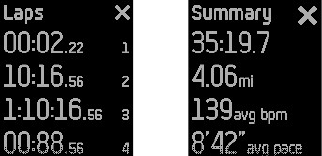
11
Pace Heart Rate Calories Clock (time of day)
5. Tap the start symbol or press the Select button to pause or resume your run.
6. If you’re on a lap run, press the Action button while you’re running to start a new lap. A
summary of the lap you just completed appears for a few seconds.
7. When you’re done with your run, tap the flag icon or press the Action button to see the summary
of your results.
8. Tap Done or press the Back button to exit the results page.
After you sync your tracker, your stats appear in the Fitbit app or on your fitbit.com dashboard.
Tracking other exercise
Besides runs, you can track several types of exercise with your Ionic. If your exercise doesn’t appear in
our list of choices, select the “Workout” exercise.
To track the exercise of your choice:
1. On your Ionic, swipe to the exercise menu.
FPO (exercise screen)
Press the Select button or tap the screen, then swipe to find the exercise you want to track. If the
exercise supports GPS, a GPS icon appears to the left of the heart rate monitor icon
FPO (Images of exercise w/GPS option vs without)
2. When you find the exercise you want to track, press the Select button or tap the screen. If you
change your mind, press the Back button to exit.
If your exercise uses GPS, the GPS searching screen appears. For best results wait for the signal
to be discovered before you start your exercise. For more information, see “Error! Reference
source not found.” on page Error! Bookmark not defined..
A stopwatch screen appears.
FPO (stopwatch screen)
12
3. Press the Select button or tap the start symbol to start your exercise.
4. While you are exercising, you can swipe to see various stats or duration of your exercise The stats
you see vary depending on the type of exercise.
5. To pause or resume exercise, press the Select button or tap the start symbol.
6. When your exercise is done, press the Select button or tap the pause icon to pause. Press the
Action button or flag icon to see a summary of your workout. You may have to scroll down to
view all the stats tracked during your exercise.
FPO (summary screen)
7. Press the Action button or tap Done to exit.
After you sync your tracker, your dashboard provides an exercise history so you can see additional details
and track your schedule and progress over time.
Using other functions during exercise
You can receive call, text, and calendar notifications or control music while running. Press the Action
button to view notifications while they’re incoming, and hold down the Action button to control music.
To see the current time during a run, swipe through the stats.
Choosing exercises to track
Your Fitbit Ionic has several exercises available and you can choose from up to 6 exercises on your
tracker at any time. You can also specify the order in which they appear when you scroll. If a specific
exercise isn’t available, use the generic exercise called “Workout.”
To change or re-order exercises using the Fitbit app, click on your tracker tile then choose the exercises
and organize the order. Sync your Fitbit Ionic to update it with the new exercise list.
You can update the exercises on your Fitbit Ionic as often as you like. Even if you remove an exercise,
any existing stats for that exercise that you’ve already tracked remain in your activity history dashboard.

13
Using Silent Alarms
Your Fitbit Ionic can gently vibrate to wake or alert you with its silent alarm feature. You can set up to 8
silent alarms to recur every day or on particular days of the week.
Setting silent alarms
You can add, edit, and delete silent alarms from the Fitbit app or fitbit.com dashboard.
To set silent alarms within the Fitbit app, tap on your tracker’s icon.
Dismissing or snoozing silent alarms
When your silent alarm goes off, your Fitbit Ionic vibrates and the screen flashes.The alarm remains
onscreen until you press the Action button or checkmark to dismiss it. You can also disable the alarm
within the Alarms screen on your device’s Menu. Tap on Alarms then press Disable.
To snooze the alarm, press the Select button or ZZZ symbol to snooze it for 9 minutes. You can snooze an
alarm as many times as you like.
Enabling or disabling silent alarms
You can disable or enable an alarm on your Fitbit Ionic.
1. Swipe to the Alarms menu on your Ionic.
FPO (Alarms menu)
2. Press the Select button or tap the screen, then swipe vertically until you see the alarm you want to
enable or disable.
FPO (screen w/a set alarm)
3. Press the bell symbol to disable or enable the alarm.
FPO (symbol to tap)

14
Receiving Call, Text, & Calendar Notifications
Over 120 compatible mobile devices let you receive incoming phone call, SMS text, and calendar
notifications on your Fitbit Ionic. To determine whether your device supports this feature, go to
http://www.fitbit.com/devices. If you have an iOS device, your Ionic can display calendar notifications
sent to your Apple calendar only.
Enabling notifications
To enable notifications on your Fitbit Ionic, you connect (“pair”) your Fitbit Ionic to the Fitbit app [will
need separate instructions for each app since Android has the encryption step]:
1. From the Fitbit Ionic menu, swipe to Settings and make sure Notifications is set to On.
2. Make sure Bluetooth is enabled on your mobile device.
3. Make sure your Fitbit Ionic is within 20 feet of your mobile device.
4. Open the Fitbit app and tap the tracker tile at the top of the mobile dashboard. [iOS instructions]
5. Enable Notifications and follow the onscreen instructions.
When your Ionic has been successfully paired for notifications, it appears as a connected device named
“Ionic” in your list of Bluetooth devices.
Viewing notifications
Fitbit Ionic receives notifications when you are within about 20 feet of your mobile device. When you
receive a call, text, or calendar invite, your Ionic vibrates and a notification appears at the top of the
screen for 7 seconds. If the caller or sender is in the contacts list on your mobile device, the name is
shown. Otherwise, the phone number of the caller or sender appears instead. The icon indicates whether
you are receiving a call, text, or calendar invitation.
FPO (screens showing icon images)
After 7 seconds, your screen dims but the notification will appear on the screen when your Fitbit Ionic
lights back up.
To view notifications, scroll up when viewing the clock screen. If you have more than one notification,
swipe up to see them all. Tap a notification to expand it for more detail. Fitbit Ionic stores a maximum of
30 notifications. If you receive more than 30 notifications, the oldest notifications are deleted as new ones
come in. Notifications delete automatically after 24 hours.
If necessary, you can swipe down to scroll through the entire contents of a text. A maximum of 32
characters of a subject and 160 characters of a text message are shown.
FPO (screen showin long text message)
15
To clear a single notification, scroll left on the message you want to delete. To clear all notifications,
scroll to the bottom of your notifications and tap Clear All.
Press the Back button to exit the notifications screen. Note that if your Ionic happens to be syncing when
your mobile device receives the call, text, or calendar invitation, you won’t receive the notification on
your tracker.
Disabling notifications
If you want to stop receiving notifications either temporarily or permanently, you can do one of the
following:
In the Fitbit app, disable Notifications
On your Fitbit Ionic, change the Notifications setting to Off
If you want to start receiving notifications again, simply change the setting.

16
Controlling Music
With a compatible iOS, Android, or Windows Phone device you can use Fitbit Ionic to pause and resume
music and skip to the next track when your mobile device is nearby.
To determine whether your device supports this feature, go to http://www.fitbit.com/devices. The Fitbit
Ionic uses the AVRCP Bluetooth profile to control music; therefore, the app providing your music must
be compatible with AVRCP. Some streaming music apps do not broadcast track information and
therefore the track title won't appear on your Ionic display. However, if an app supports AVRCP you can
still pause or skip a track, just not see its title on your Fitbit Ionic.
Enabling music control with the Fitbit app for iOS
To control music from your Fitbit Ionic, you use the Bluetooth feature on your phone to connect (“pair”)
your Fitbit Ionic with your mobile device. Pairing your Fitbit Ionic requires that you perform steps on
both your Fitbit Ionic and your mobile device in quick succession. Have them both close at hand before
continuing.
[Need instructions]
After successfully pairing your device, the Bluetooth Classic setting on your Ionic should automatically
be reset to On.
Enabling music control with the Fitbit app for Android
Enabling music control with the Fitbit app for Windows 10
If you have a Windows Phone running Windows 10, you can use the Fitbit app to enable music control on
your Ionic.
Controlling music with your Fitbit Ionic
After you have paired your device for music control, you can access the music control screen at any time.
To control music playback on your Fitbit Ionic:
1. Open a music app on your mobile device and begin playback.
2. Scroll down on the clock screen to see information about the track currently playing. If the app
you’re using does not broadcast track information, it won’t appear on your Fitbit Ionic.
3. Use the icons to pause or skip songs. You can also hold down the Action button to pause or skip
songs. Use the Action and Select buttons to control volume on your Fitbit Ionic.
FPO (screen showing song title]

17
4. Press the Back button or scroll up to return to the previous screen.
NOTE: As with other Bluetooth devices, if you disconnect your Fitbit Ionic (Classic) so you can
connect another Bluetooth device, the next time you want to use it to control music you will
have to connect it again in your Bluetooth devices list.

18
Managing Settings on your Fitbit Ionic
To customize your experience with your Fitbit Ionic, you can change a number of settings directly on the
device including:
Quick View
Brightness
Heart Rate
Regulatory Info
Version Number
Shutdown
To change settings on your Fitbit Ionic:
1. Display the menu on your Fitbit Ionic then swipe to Settings.
FPO (Settings menu)
2. Press the Select button or tap the screen, then scroll up or down to view available settings.
3. When you see the setting you want to control, tap the corresponding name or row to change the
function or to see more information.
a. Some Settings offer a feature word to the lower right. These words provide options for
that feature.
Quick View
This setting controls the Quick View function that enables your Fitbit Ionic to wake when you lift or flick
your wrist towards your chest. If Quick View is turned Off, you’ll need to press one of the side buttons to
wake your tracker
Brightness
This setting controls the conditions under which your Fitbit Ionic lights up. Available options are:
Auto (the default) – When you tap the screen or press a button,
Dim – Whenever you tap the screen or press a button, the font/text appears dimmed.
Normal – Whenever you tap the screen or press a button, the font/text appear lit up.
Max – Whenever you tap the screen or press a button, the font/text appear in the brightness
option.
The brighter your font/text, the more battery life your Fitbit Ionic will use. To save battery life, we
recommend using the Auto or Dim setting.
19
Heart Rate Tracking
This setting controls when your Fitbit Ionic heart rate monitor is active. Available options are:
Auto (the default) – The heart rate monitor is generally active only when you are wearing your
Fitbit Ionic.
Off – The heart rate monitor is never active.
On – The heart rate monitor is always active; you may want to choose this option if your heart
rate isn’t being monitored even though you are wearing your tracker.
If you remove your Fitbit Ionic but it keeps moving, for example if you put it in a pocket or backpack, it
may record an erroneous heart rate reading. You can prevent this by changing the setting to Off.
Regulatory Info
Displays technical specification information.
Version Number
Provides your Fitbit Ionic’s version number.
Shutdown
This setting turns your Fitbit Ionic off. You’ll have a chance to confirm or cancel your shutdown request.
Press any button to turn your Fitbit Ionic back on.
Regulatory Info
Displays technical specification information.

20
Updating your Fitbit Ionic
Free feature enhancements and product improvements are occasionally made available with firmware
updates provided through Fitbit Connect or the Fitbit app. We recommend keeping your Fitbit Ionic up to
date.
Updating your Fitbit Ionic takes several minutes and may be demanding on the battery. We recommend
that you charge your Fitbit Ionic before updating or while the update is in progress.
To update your Fitbit Ionic using a Fitbit app, tap on your tracker tile If there is an update available, this
will be visible here. Click on the update banner to update your Fitbit Ionic. A progress bar appears on
your Fitbit Ionic while the update is in progress.
Your tracker will display a confirmation screen when the update is complete.

21
Restarting your Fitbit Ionic
If you experience one of the following problems with your Fitbit Ionic, it may be fixed by restarting your
tracker:
It is not syncing.
It is not responding to movement.
It doesn’t respond even when in a charger.
It has a battery charge but is not lighting up.
It isn’t tracking your steps or other data.
It’s not responding to button presses, taps, or swipes.
Restarting your Fitbit Ionic does not delete any data except notifications.
To restart your Fitbit Ionic:
1. Press and hold the Home and Select buttons (left and bottom right) for 10 to 15 seconds until you
see the screen flash or start to dim.
2. Let go of the buttons.
3. After your screen turns completely off, wait 10 seconds and then press the Home button to turn
your Fitbit Ionic back on.
Your Fitbit Ionic is now restarted and should work normally.
For additional troubleshooting or to contact Customer Support, see https://help.fitbit.com.

22
Fitbit Ionic General Info & Specifications
Sensors and motors
Your Fitbit Ionic contains the following sensors and motors:
A MEMS 3-axis accelerometer, which measures your motion patterns and determines your steps
taken, distance traveled, calories burned, active minutes, and sleep quality
An altimeter, which measures floors climbed
A Bluetooth 4.0 radio transceiver
A vibration motor, which allows the Fitbit Ionic to vibrate when alarms go off, when you reach a
goal, and when you receive call, text, or calendar notifications
An optical heart rate monitor, which measures your BPM at rest and when you are exercising
An ambient light sensor, which turns on the backlight in low-light conditions
A 3-axis gyroscope
A 3-axis magnetometer
Battery
Fitbit Ionic contains a rechargeable lithium-polymer battery.
Memory
Fitbit Ionic holds detailed minute-by-minute information for the most recent 7 days, and 30 days of daily
summaries. Heart rate data is stored at one-second intervals during exercise tracking and at five-second
intervals at all other times.
Your recorded data consists of steps taken, distance traveled, calories burned, floors climbed, active
minutes, heart rate, and sleep tracked.
Sync your Fitbit Ionic regularly to have the most detailed data available to view on your Fitbit app.
Display
The Fitbit Ionic display is a touch screen with color LCD.
Environmental conditions
Operating Temperature 14° to 130° F
(-10° to 50° C)
Non-operating Temperature -4° to 95° F
(-20° to 35° C)

23
Water Resistant Splash proof. Do not shower or swim with the device.
Maximum Operating Altitude 28,000 feet
(8,535 m)
Help
Troubleshooting and assistance for your Fitbit Ionic can be found at http://help.fitbit.com.
Return policy and warranty
Warranty information and the fitbit.com Store Return Policy can be found online at
http://www.fitbit.com/returns.

24
Regulatory & Safety Notices

25
USA: Federal Communications Commission (FCC)
statement
This device complies with Part 15 of the FCC Rules.
Operation is subject to the following two conditions:
1. This device may not cause harmful interference and
2. This device must accept any interference received, including interference that may cause
undesired operation
FCC Warning
Changes or modifications not approved by Fitbit, Inc. could void the user’s authority to operate the
equipment.
Note: This equipment has been tested and found to comply with the limits for a Class B digital device,
pursuant to part 15 of the FCC Rules. These limits are designed to provide reasonable protection against
harmful interference in a residential installation. This equipment generates, uses and can radiate radio
frequency energy and, if not installed and used in accordance with the instructions, may cause harmful
interference to radio communications. However, there is no guarantee that interference will not occur in a
particular installation. If this equipment does cause harmful interference to radio or television reception,
which can be determined by turning the equipment off and on, the user is encouraged to try to correct the
interference by one or more of the following measures:
Reorient or relocate the receiving antenna
Increase the separation between the equipment and receiver
Connect the equipment into an outlet on a circuit different from that to which the receiver is
connected.
Consult the dealer or an experienced radio/TV technician for help.
This device meets the FCC requirements for RF exposure in public or uncontrolled environments.
FCC ID: XRAFB503
Notice to the User: The FCC and Industry Canada IDs can also be viewed on your device.
Instructions to view content:
1. Click left button on device
2. Tap “Settings”
3. Scroll through menu to “Regulatory Info”
The Regulatory Info menu option will display the additional regulatory information.

26
Canada: Industry Canada (IC) statement
This device meets the IC requirements for RF exposure in public or uncontrolled environments.
Cet appareil est conforme aux conditions de la IC en matière de RF dans des environnements publics ou
incontrôlée
IC Notice to Users in accordance with current issue of RSS GEN:
This device complies with Industry Canada license exempt RSS standard(s). Operation is subject to the
following two conditions:
1. this device may not cause interference, and
2. this device must accept any interference, including interference that may cause undesired
operation of the device
Cet appareil est conforme avec Industrie Canada RSS standard exempts de licence (s). Son utilisation est
soumise à Les deux conditions suivantes:
1. cet appareil ne peut pas provoquer d’interférences et
2. cet appareil doit accepter Toute interférence, y compris les interférences qui peuvent causer un
mauvais fonctionnement du dispositive
IC: 8542A-FB503
Model: FB503

27
Safety statement
This equipment has been tested to comply with safety certification in accordance with the specifications
of EN Standard: EN60950-1:2006 + A11:2009 + A1:2010 + A12: 2011 + A2:2013

1
European Union (EU)
English
Simplified EU Declaration of Conformity
Hereby, Fitbit, Inc. declares that the radio equipment type Model FB503 is in compliance with
Directive 2014/53/EU. The full text of the EU declaration of conformity is available at the
following internet address: www.fitbit.com/safety
German
Vereinfachte EU-Konformitätserklärung
Fitbit, Inc. erklärt hiermit, dass die Funkgerättypen Modell FB503 die Richtlinie 2014/53/EU
erfüllen. Der vollständige Wortlaut der EU-Konformitätserklärungen kann unter folgender
Internetadresse abgerufen werden: www.fitbit.com/safety
Spanish
Declaración UE de Conformidad simplificada
Por la presente, Fitbit, Inc. declara que el tipo de dispositivo de radio Modelo FB503 cumple con
la Directiva 2014/53/UE. El texto completo de la declaración de conformidad de la UE está
disponible en la siguiente dirección de Internet: www.fitbit.com/safety
French
Déclaration UE de conformité simplifiée
Fitbit, Inc. déclare par la présente que les modèles d’appareils radio FB503 sont conformes à la
Directive 2014/53/UE. Les déclarations UE de conformité sont disponibles dans leur intégralité
sur le site suivant : www.fitbit.com/safety
Italian
Dichiarazione di conformità UE semplificata
Fitbit, Inc. dichiara che il tipo di apparecchiatura radio Modello FB503 è conforme alla Direttiva
2014/53/UE. Il testo completo della dichiarazione di conformità UE è disponibile al seguente
indirizzo Internet: www.fitbit.com/safety

2
Australia and New Zealand
Notice to the User:
1. Click left button on device
2. Tap “Settings”
3. Scroll through menu to “Regulatory Info”
The Regulatory Info menu option will display the additional regulatory information.

3
Japan
Notice to the User: The ID can also be viewed on your device. Instructions to view content:
1. Click left button on device
2. Tap “Settings”
3. Scroll through menu to “Regulatory Info”
The Regulatory Info menu option will display the additional regulatory information.

4
South Korea
Notice to the User: The ID can also be viewed on your device. Instructions to view content:
1. Click left button on device
2. Tap “Settings”
3. Scroll through menu to “Regulatory Info”
The Regulatory Info menu option will display the additional regulatory information.
클래스 B 장치 (가정 사용을위한 방송 통신 기기) : EMC 등록 주로 가정용 (B 급)으로하고, 모든 지역에서 사용할 수 있습니다
얻을이 장치.

5
Taiwan
CCAXXXXXXX
注意!
依據 低功率電波輻射性電機管理辦法
第十二條 經型式認證合格之低功率射頻電機,非經許可,公司、商號或使用者均不得擅自變更頻
率、加大功率或變更原設計之特性及功能
第十四條
低功率射頻電機之使用不得影響飛航安全及干擾合法通信;經發現有干擾現象時,應立即停用,
並改善至無干擾時方得繼續使用。
前項合法通信,指依電信法規定作業之無線電通信。
低功率射頻電機須忍受合法通信或工業、科學及醫療用電波輻射性電機設備之干擾。
Translation:
Article 12
Without permission, any company, firm or user shall not alter the frequency, increase the power, or
change the characteristics and functions of the original design of the certified lower power frequency
electric machinery.
Article 14
The application of low power frequency electric machineries shall not affect the navigation safety nor
interfere a legal communication, if an interference is found, the service will be suspended until
improvement is made and the interference no longer exists. The foregoing legal communication refers to
the wireless telecommunication operated according to the telecommunications laws and regulations. The
low power frequency electric machinery should be able to tolerate the interference of the electric wave
radiation electric machineries and equipment for legal communications or industrial and scientific
applications.

6
United Arab Emirates
TRA
REGISTERED NO:
ER51305/17
DEALER NO:
35294/14

7
Mexico
IFETEL: XXXXXXXXX-XXXX
La operación de este equipo está sujeta a las siguientes dos condiciones: 1. Es posible que este equipo o dispositivo
no cause interferencia perjudicial y 2. Este equipo o dispositivo debe aceptar cualquier interferencia, incluyendo la
que pueda causar su operación no deseada
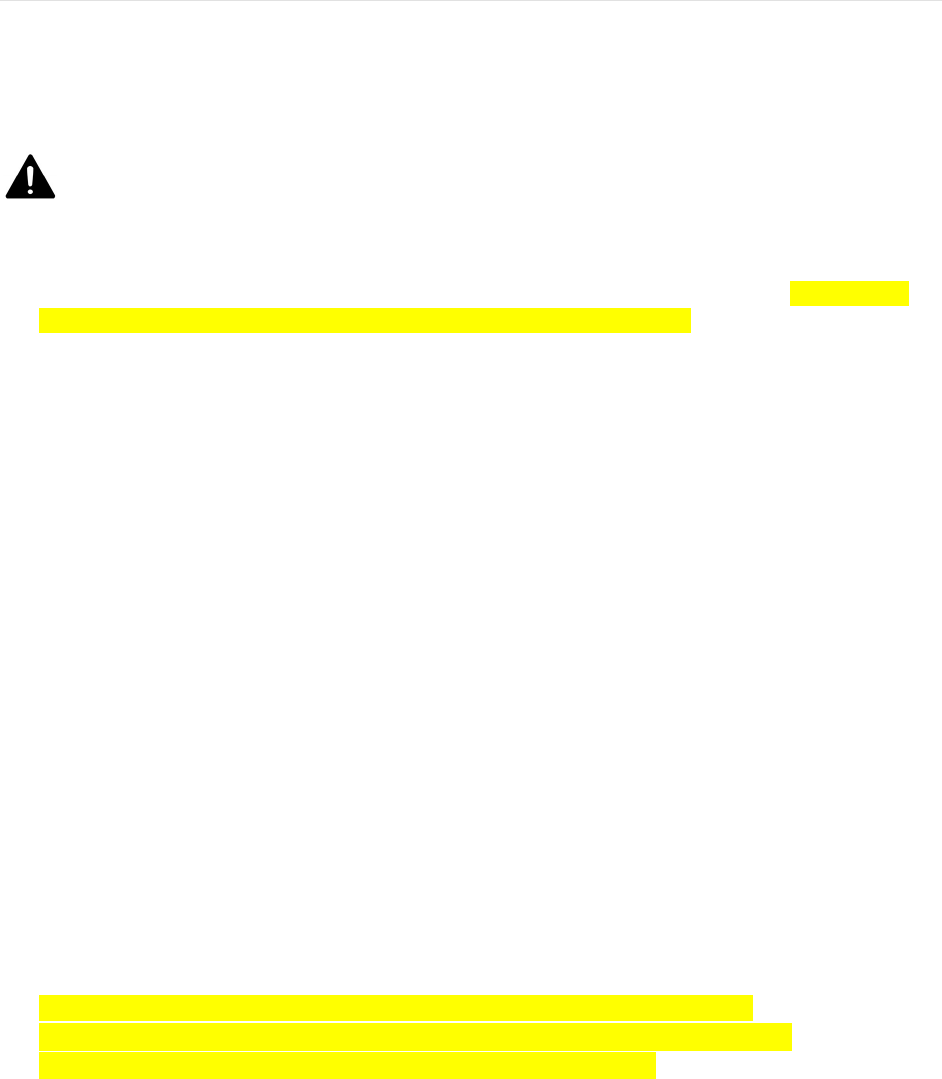
8
Safety statement
This equipment has been tested to comply with safety certification in accordance with the specifications
of EN Standard: EN60950-1:2006 + A11:2009 + A1:2010 + A12: 2011.
Important safety and product information
Prolonged contact may contribute to skin irritation or allergies in some users. To reduce irritation,
follow four simple wear and care tips: (1) Keep it clean; (2) keep it dry; (3) don’t wear it too tight,
and (4) give your wrist a rest by removing the band for an hour after extended wear. Use skin care
products sparingly on the areas of the skin covered by your Fitbit product.
For more information visit www.fitbit.com/productcare. If you notice any kin irritation, remove
your device. If symptoms persist longer than 2-3 days after removing the device, consult your doctor.
The device contains electrical equipment that could cause injury if not handled properly.
If you feel soreness, tingling, numbness, burning or stiffness in your hands or wrists while or after
wearing the product, please discontinue use.
Do not attempt to replace the battery or open the enclosure or disassemble your Fitbit product.
Doing so will void the warranty and can result in a safety hazard.
Do not use your Fitbit product if your display is cracked.
Substances in this product and its battery may harm the environment or cause injury if handled
and disposed of improperly.
Do not expose your Fitbit product to extremely high or low temperatures.
Do not use your Fitbit product in a sauna or steam room.
Do not use abrasive cleaners to clean your Fitbit product.
Remove your Fitbit product if it feels warm or hot.
Do not dispose of your Fitbit product in a fire. The battery could explode.
Charge the battery in accordance with the instructions provided during setup. Only use a
computer, powered hub or power supply that is certified by a recognized testing laboratory and an
authorized Fitbit charging cable.
Do not wear your Fitbit product while charging it.
Do not charge your Fitbit product while it is wet.
Do not place your Fitbit product in a dishwasher, washing machine, or dryer.
Do not leave your Fitbit product in direct sunlight for an extended period of time.
Your Fitbit uses a California Energy Commission battery charger.
CAUTION The device may cause skin irritation

9
CAUTION: Consult your doctor before beginning or modifying any exercise program.
CAUTION: Consult your doctor before use if you have any preexisting conditions that might be affected
by your use of this Fitbit product.
CAUTION: Do not check call or other notifications, or other applications on the product’s display while
driving or in other situations where distractions could be hazardous. Always be aware of your
surroundings when exercising.
CAUTION: This product is not a toy. Do not allow children or pets to play with your Fitbit product.
The product contains small components that can be a choking hazard.
This product is not a medical device, and is not intended to diagnose, treat, cure, or prevent any
disease. With regard to accuracy, Fitbit has developed leading hardware and algorithms to track
fitness information and is constantly improving its products to calculate measurements as
accurately as possible. The accuracy of Fitbit devices is not intended to match medical devices or
scientific measurement devices, but is intended to give you the best information available in a
wearable activity tracker.
Please refer to fitbit.com for specific information regarding water resistance.
For additional information on using your Fitbit account, visit www.fitbit.com/terms.
Disposal and recycling information
The symbol on the product or its packaging signifies that this product must be disposed of separately from
ordinary household wastes at its end of life because it contains a battery and is electronic equipment.
Ensure that you dispose of your Fitbit product at a recycling center. Each country in the European Union
has its own collection centres for batteries and electronic equipment recycling. For information about
where to recycle your Fitbit product, please visit help.fitbit.com, or contact your local waste management
authority or the retailer where you bought the product.
Special notice for devices with PurePulse Technology: PurePulse products have
a heart rate tracking feature that may pose risks to users with certain health
conditions. Consult your doctor prior to use if you:
Have a medical or heart condition
Are taking any photosensitive medicine
Have epilepsy or are sensitive to flashing lights
Have reduced circulation or bruise easily
Have tendonitis, carpal tunnel syndrome, or other musculoskeletal disorders